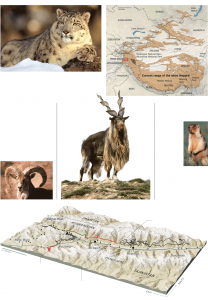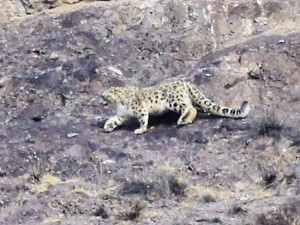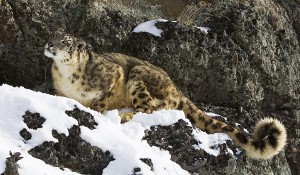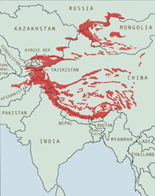
President Almazbek Atambayev of the Kyrgyz Republic supporting the Bishkek Declaration on the conservation of snow leopards and their ecosystems. (Photo SLT).
As a followup to last month’s historic meeting in Bishkek Kyrgyz Republic, here is the full document of the declaration by all 12 snow leoaprd range countries to save the species and protect its environment.
We, as leaders in the governments of the Islamic Republic of Afghanistan, the Kingdom of Bhutan, the People’s Republic of China, the Republic of India, the Republic of Kazakhstan, the Kyrgyz Republic, Mongolia, Nepal, the Islamic Republic of Pakistan, the Russian Federation, the Republic of Tajikistan, and the Republic of Uzbekistan, the custodians of the world’s snow leopards and the valuable high-mountain ecosystems they inhabit, having gathered at a Global Snow Leopard Conservation Forum in Bishkek, Kyrgyz Republic, from 22-23 October 2013, with the shared goal of conserving snow leopards and their fragile habitats;
Acknowledge that the snow leopard is an irreplaceable symbol of our nations’ natural and cultural heritage and an indicator of the health and sustainability of mountain ecosystems;
Recognize that mountain ecosystems inhabited by snow leopards provide essential ecosystem services, including storing and releasing water from the origins of river systems benefitting one-third of the world’s human population; sustaining the pastoral and agricultural livelihoods of local communities which depend on biodiversity for food, fuel, fodder, and medicine; and offering inspiration, recreation, and economic opportunities;
Express strong concern about the increasing threats arising from growing human footprint and climate change to the survival of snow leopards and associated mountain biodiversity and to the maintenance of watershed and ecosystem services their habitats provide;
Affirm the need for urgent collective action to conserve snow leopards and their fragile habitats;
Understand that the conservation of the snow leopard must be achieved by securing the involvement, livelihoods, and balanced development of human communities who share the habitat, striving to reconcile the conflict between economic growth and environmental sustainability;
Reconfirm that conserving snow leopards and their habitats is a shared responsibility of our countries, the international community, civil society, and the private sector;
Reiterate the importance of international conventions and agreements on the conservation of biological diversity and protection of endangered species, including snow leopard.
Given our commitment to present and future generations, we must act now with resolution and authority to protect and recover snow leopard populations and their fragile habitats for all people to enjoy. We, the Snow Leopard Range Countries, resolve to work together to:
- Evaluate and map the current status of key snow leopard populations and habitats to set baselines and indicators against which to assess future change, conduct economic valuation of snow leopard habitats, and intensify scientific research and monitoring to support future policy and action.
- Intensify conservation efforts in the large landscapes required for snow leopard survival by identifying and designating critical habitats of key snow leopard populations as no-go areas for destructive land uses, maintaining their integrity and connectivity through natural corridors, and strengthening their protection on the ground.
- Enhance the role of local communities in snow leopard conservation efforts by adopting and implementing policies and laws that favor the involvement of such communities as stewards of biodiversity and champions of conservation.
- Take firm action to stop poaching and illegal trade of snow leopards and other wildlife by adopting comprehensive legislation, strengthening national law-enforcement systems, enhancing national, regional, and international collaboration, and developing effective mechanisms to eliminate the illegal demand for snow leopard and other wildlife products.
- Encourage meaningful participation of industry and the private sector in snow leopard conservation.
- Ensure that industry, mining, infrastructure, and rural development programs and projects are fully sensitive to the conservation needs of snow leopards and their ecosystems, do not adversely affect or fragment key populations or critical habitats, and employ wildlife-friendly design, offsets, and other mitigation tools.
- Increase bilateral and regional cooperation for snow leopard conservation in transboundary landscapes.
- Strengthen capacity for community-based conservation, law enforcement support, and wildlife and ecosystem management, among policy makers, front-line managers and staff, community leaders, and civil society by supporting knowledge exchange and communities of practice and communication and cooperation among stakeholders.
- Communicate to citizens and particular stakeholders, including local communities, youth, governments, civil society, and the private sector, about the value of snow leopards and their ecosystem, and sustain the effort by celebrating 23 October 23 each year as the International Snow Leopard Day with presentation of an annual International Snow Leopard Conservation Award, and 2015 as the International Year of the Snow Leopard.
As the trustees of the will of our peoples, we:
Endorse a comprehensive, long-term Global Snow Leopard Conservation Program (“Program”).
Resolve to commit resources for its implementation, including mobilization of financial and technical support from the international community, and welcome and sincerely appreciate the pledges to support the Program made during the Global Snow Leopard Conservation Forum.
Agree to form a high-level Steering Committee to guide Program implementation, regularly review its progress, and maintain a strong political commitment to its objectives, and to establish a Program Secretariat to coordinate Program implementation that is adequately resourced and staffed by the range countries and the international community.
Agree to establish a Working Secretariat in Bishkek, Kyrgyz Republic, to facilitate Program development after the Global Snow Leopard Conservation Forum.
Appreciate the support of the Global Environment Facility, Global Tiger Initiative, Nature and Biodiversity Conservation Union (NABU), Snow Leopard Conservancy, Snow Leopard Trust, United Nations Development Programme, United States Agency for International Development, World Bank, World Wildlife Fund, and others for the cause of snow leopard conservation, and invite all interested stakeholders to expand partnerships to enhance the Program.

















